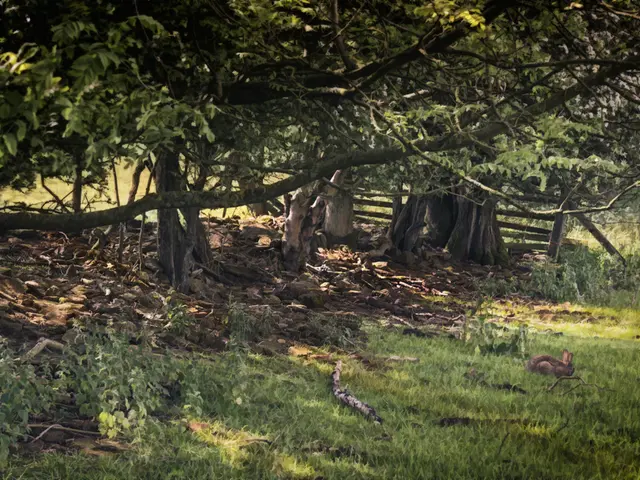In the face of scorching temperatures sweeping across the UK, here's some advice for gardening under extreme heat conditions.
Rebooting Your Green Space in a Changing Climate
As the mercury rises in the UK, we had a candid chat with three expert RHS horticulturists - Nikky Barker, Julie Henderson, and Adrian Thorne - about the impact of the scorching heat and drought on our gardens, and the necessary adjustments we need to make to adapt to these weather extremes.
Their insights aren't just about managing water wisely; it's about reimagining your garden to withstand our unpredictable climate.
Navigating Drought:
- The Challenges Ahead: Find out how this year's drought is affecting gardens across the UK and what it means for wildlife.
- Preferred Plants for Drought-Prone Gardens: Discover the ideal flora that can grace your green space while enduring prolonged dry spells.
- Drought-Tolerant Planting in the UK: Is it a practical approach in our islands' climate, or just a distant dream?
If you're a gardener in the UK, you've got more on your plate than keeping your space lush and green. Here are key factors to consider in building a drought-resilient garden:
- Crafting a Resilient Garden: This means carefully selecting plants that can stand up to heat and drought, as well as implementing water-saving practices.
- Water Conservation Techniques: Explore ways to save water, care for your soil, and make the most of every raindrop.
- Mulching Magic: Learn how applying mulch, especially in autumn, helps conserve water and strengthen your garden against harsh winds.
- Preparing for Rain: Tips to handle sudden, intense downpours and optimize water storage in your garden.
- Adjusting Your Planting: Discover Mediterranean planting options and other resilient plants that thrive in hotter, drier climates.
- Lower Maintenance, Higher Resilience: Uncover perennials and other plants that can survive with minimal attention, making your garden more adaptable to the heat.
How Alarming is This Year's Drought?
Our poor gardens have taken a beating this year, with an official drought declared in the north-west on May 21 and Yorkshire joining the club on June 12. Experts believe spring was unusually dry, with just 22 days of almost no rainfall in May, and England experiencing its driest spring since 1893.
So, what impact will this have on our gardens and the wildlife they support?
Effect of Extreme Weather on the Garden and Wildlife:
- Shortened Blooming Season: Many plants will suffer from reduced flowering periods, which can have knock-on effects on pollinators.
- Struggles for Insects: With plants flowering earlier in the year, some insects may miss out on essential food sources. This can ripple through the ecosystem and even affect the quantity of fruit and vegetables grown.
- Woes of Hydrangeas and Acers: These popular garden plants require consistent moisture and may wilt under the dry, relentless summer heat.
- Troubles for Cherries: Warmer temperatures can negatively affect the fruiting process of cherries, which need a mild winter period to properly flourish.
- Challenges to the Soil Microbiome: As the soil dries out, crucial microorganisms, like worms, will retreat, reducing their beneficial impact on the soil.
- Rise in Diseases and Fungi: As climates change, some pests and diseases may become more prevalent, affecting both our gardens and the plants we choose to grow.
Adapting Your Garden to Drought Conditions:
Lawn Care:
- Reconsider your lawn obsession: traditional urban grass is not only water-guzzling, but it's also poor for pollinators.
- Make smart choices when picking grass seeds: utility lawn mixes tend to be more resilient.
- Don't mow too short: longer grass is more drought-resistant.
- A brown lawn will bounce back with proper care. To save water, consider skipping lawn watering for now.
Water Saving Measures:
- Prioritize your watering: Focus on new plants and those most in need.
- Targeted Watering: Use watering cans to water near the roots of your plants, rather than spraying the entire border.
- Install a water meter: This helps conserve water by encouraging mindful usage.
- Set up rainwater collection: Install rainwater butts from house drainpipes to collect water for your garden.
- Reuse grey water: Save water from washing machines and baths for established plants, excluding fruit and vegetables.
- Optimal Watering Times: Water in the early morning or evening, when temperatures are cooler, to minimize evaporation.
Mulching:
- Mulching goes a long way in the long run. Apply mulch, such as compost or bark, to keep moisture in the soil and protect plants from strong winds.
Dry Garden Planting Combinations:
Looking for inspiring ideas on how to plant a dry garden? Check out our expert guide!
Water Storage and Design:
Prepare for heavy, focused rainfall by creating runoff storage systems to make the most of every drop.
Adapting Your Planting for Wet and Dry Conditions:
- Learn how to balance adaptability to both dry and wet conditions by focusing on raised beds, mound planting, or water harvesting systems for your garden.
Resilient Plant Choices:
- Discover the best drought-tolerant plants for your UK garden, including annuals like nasturtiums and love-in-a-mist, as well as Mediterranean options like lemon trees.
Tough It Out:
Instead of mollycoddling your plants, choose the right species to survive in harsh conditions. Opt for poor soil and less water to help plants develop hardiness and resilience.
Embrace a More Pragmatic Approach:
Move towards less manipulation of the soil and plants and focus on improving the soil naturally, without relying on artificial fertilizers and irrigation. Allow plants to adapt and thrive with minimal intervention.
Inspiring Examples of Dry Gardens:
- Get inspired by visiting gardens that excel in dry conditions, like last year's Hampton Court Palace Flower Show's Planet Friendly Garden and Turfed Out garden, or Beth Chatto's dry garden that hasn't been watered since planting.
Explore More:
Learn more about how drought affects gardeners in the UK, and discover the best approaches to building a stunning, resilient garden in our changing climate.
[1] https://www.rhs.org.uk/plants/find-out-more-about-plants/plant-finder/sort-by/drought-tolerant[2] https://www.theguardian.com/lifeandstyle/gardening-blog/2018/aug/22/best-plants-for-a-dry-garden[3] https://www.telegraph.co.uk/gardening/how-to-grow/how-to-create-a-drought-resistant-garden[4] https://www.bbc.co.uk/gardening/howto/drought_tolerant_gardening[5] https://www.independent.co.uk/life-style/gardens/plants/10-plants-that-can-survive-a-drought-10620128.html
- In the midst of the UK's scorching heat and drought, it's crucial to reimagine gardens to withstand our unpredictable climate.
- As our gardens face the challenges of this year's drought, it's essential to learn about the ideal plants that can grace dry-spell gardens.
- Crafting a resilient garden involves carefully selecting drought-tolerant plants and implementing water-saving practices like mulching, water conservation techniques, and lawn care.
- The unprecedented drought in the UK has resulted in an official declaration in the north-west and Yorkshire, with the spring being England's driest since 1893.
- The effect of this extreme weather on gardens and wildlife includes a shortened blooming season, struggles for insects, woes for certain plants like hydrangeas and acers, challenges to the soil microbiome, and a rise in diseases and fungi.
- Adapting gardens to drought conditions can be achieved through various measures, such as water-saving techniques, mulching, dry garden planting combinations, water storage and design, and resilient plant choices.
- To build a stunning, resilient garden in our changing climate, it's essential to explore inspiring examples of dry gardens, learn about the best drought-tolerant plants, and embrace a more pragmatic, natural approach to gardening.








